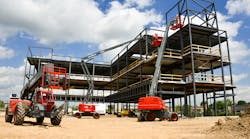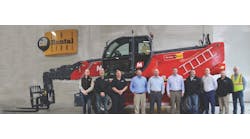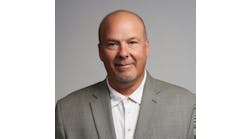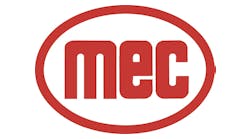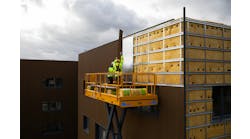RER interviews Brad Boehler – president, Skyjack about new autonomous technologies, telematics, railing heights on scissorlifts, new ANSI training standards, hybrid trends and more.
RER: What have been the major new developments to your company’s technology and products in the past year?
Boehler: Skyjack launched our new range of full-size rough terrain scissor lifts earlier this year. At the ARA show in Anaheim we unveiled our largest scissor lift to date – the SJ9253 RT. And we have plans for an even larger 63-foot machine at the turn of the year.
The new range will replace Skyjack’s existing 88 and 92 models and consists of the SJ9233, SJ9243, and SJ9253 RT with plans for the SJ9263 RT later on. These models boast expansive platform space, increased capacities, and increased working heights across the board. Features like our AXLDRIVE four-wheel-drive system and easily accessible service components remain standard in these new models.
Secondly, after a very successful launch of our ELEVATE telematics solution in 2018, we used the 2019 ARA show to show a concept self-check machine. We engineered a SJ3215 DC scissor lift to respond to commands sent over the cellular network, and independently perform a function check of its critical systems such as drive, steer, and lifting. The reception was extremely positive and this demonstration, in my point of view, symptomatic of the way that technology will influence our industry. Think less robots performing complex functions, and more discrete tasks that can be made autonomous and increase productivity.
Practical technologies leading to discrete autonomous tasks have begun to be wholeheartedly embraced as more rental companies have started seeing the real potential for operational improvements, the opportunities to engage with their customer base more effectively and add value to their service offering.
For people who have not been following the ANSI changes, can you sum up how your equipment will change on a practical jobsite level – in other words, what will the customer find different?
Aside from the updated equipment name -- Aerial Work Platforms (AWPs) becoming Mobile Elevating Work Platforms (MEWPs) -- the core design changes in effect with ANSI A92.20 include: load sensing to be implemented on most machines, revised machine specifications due to updated stability requirements (including wind force), entrance gates, railing heights, and the type of tires utilized (on some equipment).
From an equipment standpoint, the largest impact the operator will see is the addition of load sensing systems on most MEWPs. Many MEWPs will soon be equipped with load sensing devices that will disable the normal elevating functions if overloaded.
Emergency lowering controls will still be enabled to safely bring the platform to the ground, if necessary. Rental companies and contractors alike should be aware that jobs which had previously been inappropriately completed by overloading a machine will require different planning and execution with new units that will be designed to inhibit this misuse.
The more stringent stability testing means that more foam-filled tires may be the norm on jobsites for rough terrain scissor lifts and booms. Railing heights on scissor lifts have increased, so scissors that could previously fit through a standard size doorway will no longer have that ability without folding railings. So, OEMs will be making an increasing number of units with folding rails as standard, as well as half-height or full-height gates, complete with toe board, replacing the previous chain gate that was seen on some models.
For rental people, how will their responsibilities change with the new ANSI standards?
As I mentioned earlier the largest machine change seen with the new ANSI design standards is the addition of load sensing technology. For a rental company, it’s important to educate users about the new experience they’re likely to encounter as a result of this and make their customers aware of other changes to the requirements regarding the use of and training for this machinery. Skyjack has prepared educational materials to help alleviate the burden from rental companies. They can all be found at www.skyjack.com/new-ansi.
What do you suggest rental people do to communicate with their customers about the new ANSI standards?
In addition to print-ready material that rental companies can simply print and distribute to their customers, Skyjack has also created two white papers that highlight the core design changes, as well as changes specific to Skyjack equipment. All of these resources are available online and are free to use and distribute.
How will training programs change with the implementation of the new standards?
Under the new ANSI training standard (A92.24), when requested, dealers must either offer operator training or advise where users can obtain operator training by a qualified person who is experienced with the particular classification of MEWP and knowledgeable regarding the laws, regulations, safe use practices, manufacturer’s requirements, and recognition and avoidance of hazards associated with MEWPs. The curriculum, training environment, testing, documentation and record retention must also meet the requirements of the A92.24 standard, and the training must be presented in a manner that the trainee can understand.
For the end user, training is still mandatory across the board when operating a MEWP, however ANSI A92.24 stipulates that training must extend past the operators and include supervisors as well. MEWP supervisors (who monitor operator performance and supervise their work) are to be trained according to requirements from ANSI A92.24, including: awareness of the applicable MEWP rules, regulations and standards, potential hazards and methods for mitigating the risk, proper MEWP selection for the task, and knowledge of the manufacturer’s operation manuals.
What new safety measures have you implemented in the past year?
In 2018 Skyjack launched a Secondary Guarding Lift Enable (SGLE) as an option on vertical mast, DC scissor lifts, and rough terrain scissor lifts. With Skyjack’s SGLE, both joystick and tamper-proof secondary enables must be activated to allow the platform to lift – the release of either will stop the functions. The SGLE specifically requires operators to remain in an upright position with two hands on the control box. This helps to keep the operator’s body away from the guardrails, which reduces the risk of crushing or entrapment while raising the platform. The secondary enable button is not used for lowering the platform or for driving; those functions remain joystick-enable only.
Are you seeing an increase in demand for electric and hybrid machines and is your company or will your company participate in that market?
Obviously, a large part of our product range is electrically powered in the form of scissors. Looking at booms, we do see a movement away from internal combustion sources. That has mostly been a European trend so far, with North America a little more circumspect. We will be in that market with our focus on hybrid. However, importantly we believe the “job” should specify the machine rather than the technology changing the job. All too often we see performance compromises as a result of technological introduction that mean rental companies have to change their existing and proven processes.
Finally we believe that unless the technology brings operational improvements, that technology has to be supplied at the same going rate as the more conventional offering. Technology itself does not change the laws of economics.
Obviously, the rental industry is a major market for your equipment. Do you see any particular trends in the rental market that you’ve noticed? Have you seen new start-ups, new players coming into the rental market?
I think in Europe we see the technology trend we discussed early in terms of power sources. My feeling is that Europe is undergoing a period of some considerable rental company consolidation. Turning to North America consolidation continues to play a role with some bigger hitters coming together.
In both markets the acceptance of new technology is picking up. Telematics has moved from a phase of being just about connectivity to a stage where rental companies are actively looking at and acting upon data to improve operational performance. I look forward to some of the advances in this area. Personally, I believe digital products represent a great opportunity for operational improvements and for OEMs to differentiate themselves. The ongoing success and adoption rate of our OEM-delivered solution ELEVATE is proof of that.
